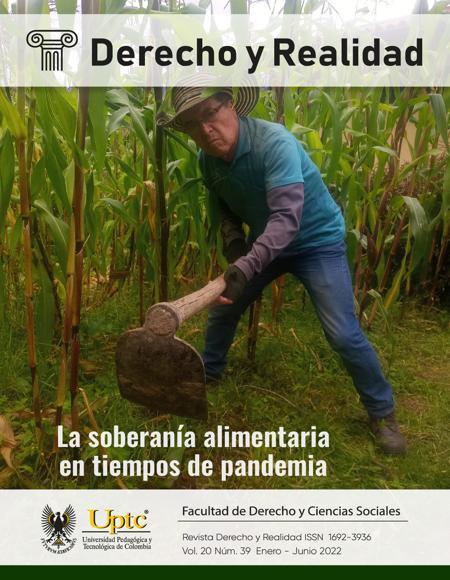Labeling of transgenic foods in Colombia and the power of information

Abstract
The importance of labeling transgenic foods lies in the fact that labels constitute the communication mechanism between the producer and the consumer of a food; information that gives people the possibility to make rational decisions regarding food consumption, however, the omission regarding the mandatory labeling of transgenics present in Law 1480 of 2011, makes it difficult for people to exercise the right to make rational decisions regarding the consumption of transgenic foods. Consequently, the main objective of this article is to analyze the criteria of precaution and substantial equivalence applicable to the labeling of foods from genetically modified organisms -APOGM-, in order to make visible the importance of clear legal parameters in terms of labelled; understanding the labeling of transgenic foods as a presupposition to guarantee in Colombia the right to decide how to feed oneself, outlining the need for mandatory APOGM labeling to respond to the consumer's right to decide as a presupposition for human dignity and a protective mechanism for food sovereignty. With the aforementioned purpose, for the development of this article, the qualitative method was used, starting from the study of the APOGM labeling in the country and its incidence in terms of food sovereignty and guarantee of consumer rights, for this purpose the review of regulations, jurisprudence and scientific and academic literature on transgenic foods and their labeling; It is intended to glimpse the importance of strict food labeling, an issue that, referring to foods from genetically modified organisms, acquires relevance, since the label constitutes the means of control available to people to guarantee food sovereignty.
Keywords
GMOs, Economy, Environment and labeling
Author Biography
Johanna Katherine Aguilera A.
Abogada. Especialista en Derecho Administrativo. Magister en Derechos Humanos de la Universidad Pedagógica y Tecnológica de Colombia-UPTC
References
- Acuerdo Final para la Terminación del Conflicto y la Construcción de una Paz Estable y Duradera. (24 de noviembre de 2016). Acuerdo final para la terminación del conflicto y la construcción de una paz estable y duradera.
- Agrobio. (2021). ¿Cómo se etiquetan los alimentos. Enero 2021. Disponible en: ww.agrobio.org.
- Aguilera, J. K. (2021). Transgénicos en Colombia y el derecho a decidir cómo almentarse, diciembre de 2021. Tunja, Colombia.
- Álvarez de Luis, A. (2017). Alimentos transgénicos: Factores culturales que explican su aceptación o rechazo. Tesis Doctoral. Murcia, España. Universidad de Murcia, pp. 124-128.
- Ardisana, E. (2019). Alimentos transgénicos: ¿SÍ o no? la Perspectiva. Revista Chakiñan, pp. 148-155.
- Arnaiz, M. G. (2004). Pensando sobre el riesgo alimentario y su aceptabilidad respecto a alimentos transgénicos. NUTRICAO, 17(2), pp. 125-149. Disponible en: https://www.scielo.br/scielo.php?pid=S1415-52732004000200001&script=sci_abstract&tlng=es
- Barrantes, R. (2021). Derecho al Consumidor ¿sabes lo que comes? MAPORRUA.
- Chavero, E. L. (2008). La invención de los transgénicos: ¿nuevas relaciones entre naturaleza y cultura? Nueva antropol vol. 21 no.68, pp. 9-35.
- Comisión Económica para América Latina. (2001). organismos genéticamente : su impacto socioeconómico en la agricultura de los países de la Comunidad Andina, Mercosur y Chile. Santiago de Chile.
- Congreso de la República de Colombia, Ley 1480 (2011).
- Corte Constitucional, Sentencia C-519 (Corte Constitucional 1994).
- Corte Constitucional, Sentencia C-583, Expediente D-10608 (Corte Constitucional 8 de septiembre de 2015).
- Fuentes, A. P. (2021). Ley de la comida chatarra: Colombia implementa el etiquetado frontal de advertencia. Periodico UNAL, agosto 2021.
- Giménez, G. (2010). Cultura, identidad y procesos de individualización. México: Universidad Nacional Autónoma de México. Enero de 2010.
- Larrión, J. (2016). ¿Qué signifi ca estar bien informado? Retóricas,. Reis. Rev.Esp.Investig.Sociol. ISSN-L: 0210-5233. Nº 153, pp. 43-60.
- Ministerio de Medio Ambiente y Desarrollo. (1994). Ley 165 de 1994.
- Montiel, G. G. (2007). Sobre las Culturas e identidades sociales. Mexico: Instituto Tecnólógico de estudios de occidente.
- Nemoga, G. R., Chaparro, A., & Keyeux, G. G. (2007). Los cultivos transgénicos en el contexto Latinoamericano. Pensamiento Jurídico No. 18. Bogotá, Colombia, pp. 131-140.
- Polo, K. L. (2017). Seguridad alimentaria y alimentos transgénicos. Obs. Medioambiental, pp. 59-75.
- Quintanal, H. S. (2006). Territorialización e identidades en el espacio rural. 6 de octubre de 2006. Disponible en: https://halshs.archives-ouvertes.fr/halshs-00104339/document
- Rebollo Carrasco, M. (2003). El principio de precaución y la defensa de los consumidores. Universidad de Córdoba, pp. 185-236.
- Saavedra, J. E. (2009). Implicaciones ambientales del uso de transgénicos en Colombia. Bogotá , Colombia. Pontificia Universidad Javeriana.
- Sánchez, E. (2003). El principio de precaución: implicaciones para la salud pública. Gaceta Sanit, pp. 372-373.
- Vargas-Roncancio, I. D. (2010 ). Elementos para una evaluación de los cultivos transgénicos. Rev. maest. derecho econ. Bogotá (Colombia) Vol. 6 N° 6, pp. 143-178.
- Villalobos Hernández, M. E., & Espinoza Esquive, A. M. (2008). Concepto de equivalencia sustancial aplicado alimentos derivados de cultivos. Revista Costarricense de Salud Pública, pp. 52-57.
- Yunta, E. R. (2013). Témas éticos en investigación internacional con alimentos transgénicos . Acta Bioethica 2013, pp. 209-218 .